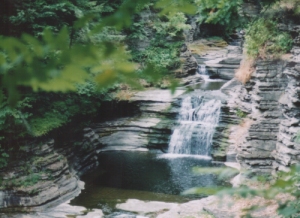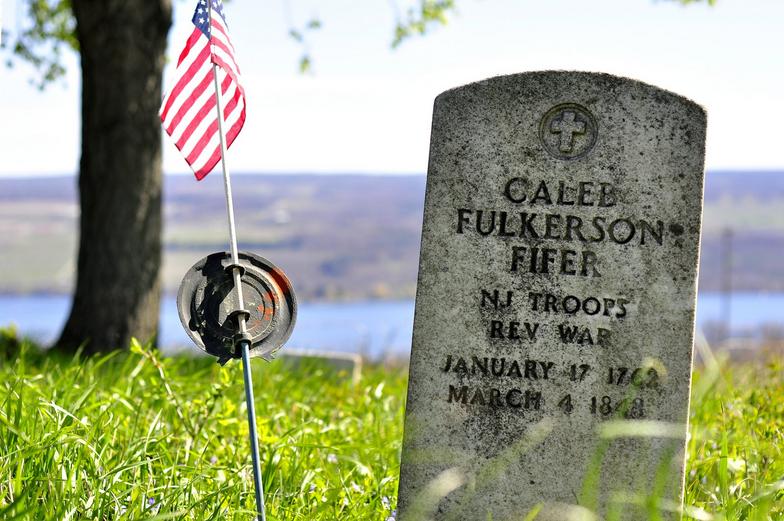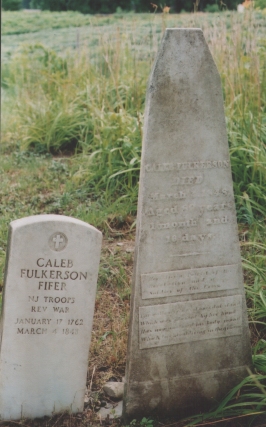The Fulkerson Family Pages
The Household of Caleb and Deborah Tunison Fulkerson, Est. April 6, 1787
After the Revolutionary War ended, Caleb returned home to New Jersey to become a tailor. He was on the tax rolls in Bridgewater Township, Somerset County, in July, 1785 and again in August, 1786.
Caleb Fulkerson was 25 years old when he married Deborah Tunison (27 Jul 1772-28 Dec 1859) on 6 Apr 1787. Seven children--Philip (1789), Margaret (1791), Deborah (1793), Joseph (1796), Ann (1799) Letticia (1802), and Elinor (1804)--were born in New Jersey, prior to a move to the State of New York in 1805.
Locating in Newton (Elmira), New York, Caleb had received 640 acres of bounty land on the western shore of Seneca Lake. At their new home, the family welcomed four more siblings. First to arrive were twins Peter M. and Samuel (1807), then Caleb Jr. (1809), Rebecca (1811), and their youngest child, William G. (1813).
At the time of little William's arrival, Caleb, Senior, had reached the ripe old age of 51. His wife, Deborah, who had married Caleb when she was a young fourteen years old, was aged 40 when her twelfth child and youngest son William was born.
Deborah's great-great-grandfather, Theunis Nyssen, was born about 1615 and lived in the village of Binneck, Province of Utrecht, Netherlands. He emigrated to New Amsterdam in 1638. On 11 February 1640 Theunis married Phaebea Fallix, widow of Hendrick the Boor. It was the third recorded marriage in the New Amsterdam Dutch Reformed Church.
Caleb continued to appear on the tax rolls for Bridgewater from 1789 through the summer of 1793. Other Fulkersons listed on Bridgewater tax rolls during that time included Captain Philip, Dennis, Derrick, Fulkert, Hendrick, Philip and Philip Jr., and Samuel. Caleb and Deborah moved to Newton (now Elmira), New York. Caleb first appeared on a tax roll there on 1 Oct 1798, an "Assessment Roll or Descriptive List of the houses, lots, etc. in the 6th Assessment District of the 9th Division of the State of New York" in the county of Chemung [Source: "BRIGHAM’S ELMIRA DIRECTORY, FOR 1863"].
Caleb chose a 640-acre site at Starkey, on the hillsides of the western shore of Seneca Lake. (The farm there still remains in the family, planted with orchards and vineyards, as the "Fulkerson Wine and Juice Plant.")
When Caleb walked about the Seneca Lake countryside in 1805 to pick out the land he wanted, he cut a willow branch and used it as his walking stick. After several days he found what he wanted and stuck the branch into the bank of a spring to signify his intention to stay. Later it sprouted some leaves and grew into a tree. Many years later he cut the tree down and sawed the wood into lumber to make caskets for himself and his wife.
The History of the Settlement of Steuben County, New York, by Guy McMasters [1853] tells us that Caleb Fulkerson was among the earliest settlers at Reading Centre, "about the year 1806." Caleb appeared on the 1810 Census at the Town of Reading, Steuben Co., NY. His neighbors, listed on the same census page per a Bunce family site, were Jonas Bunce, Abner Hurd, Philemon French, Mathew Rice, Ezra Keeler, Timothy Hurd, John Sears, Andrew Boothe, Sherman Hurd and Conrad Royce.
Caleb was active in developing uses for his land, including farming and milling. Some of this activity including buying and selling neighboring properties. From the Starkey Biographies, p. 1071, we learn he was involved in land purchases at Big Stream Point on Seneca Lake:
Nathaniel Pendleton conveyed in 1816 to Caleb Fulkerson, lot 1 0f section 10 of Watson’s Patent, containing 123 acres for $555.75. In 1818 Caleb Fulkerson conveyed to William W. Folwell of Romulus, 37 acres of lot 1, embracing the mill seat.
[History & Directory of Yates Co., Vol II, Pub 1873, by Stafford C. Cleveland]
That same publication tells us in an article on the Lannings, pp. 928-932:
Isaac Lanning relates that when he came to Eddytown in 1806, Caleb Fulkerson had a long tavern at the south end of Eddy’s Settlement, on the west side of the highway.
The "History of Yates County, NY" published 1892, by L.C. Aldrich, confirms this by telling us:
Caleb Fulkerson and Andrew Harrison kept inns in 1808, the first in the town.
The index of the "Town of Starkey, Record of Roads, 1826 - 1874" listed Caleb's inn as a tavern.
Philip............(1789), m. Eunice TORRANCE & moved to Marshall, Michigan
Margaret.......(1791), m. William GOUNDRY, four children
Deborah........(1793), m. Richard HURD, six children, lived in Steuben Co., NY
Joseph.........(1796), m. Mary Ann NORMAN, four children, drowned age 32 repairing mill wheel
Anna............(1799), m. Thomas CULVER, lived at Montour, NY
Letticia.........(1802),
Elinor...........(1804),
Peter M........(1807), twin), m. Lucinda POTTER, nine children, moved to Ovid, Michigan
Samuel........(1807), m. Jane NORMAN in 1831, seven children, stayed on father's farm
Caleb Jr.......(1809), m. Delia WEBSTER, eight children, moved to Michigan
Rebecca......(1811),
William G....(1813). m. Ruby ROYCE, moved to Ovid, Michigan
He died on 4 March 1848, at the age of 86.
In 1805 Caleb received a tract of land in the Finger Lakes region as a bonus for his Revolutionary war service--this land was formerly the land of the Six Nations of the Iroquois. These Native Americans had adopted many of the European ways by the 1770's--they had stone houses with glass windows, well-developed orchards, and fine farms.
During the American Revolution, tragically, these remaining Iroquois had sided with the British and raided American frontier settlements. In 1779, an American military expedition raided and burned their towns and farms. The expedition did not kill or capture many Iroquois, though, and so left them intact as a hungry, desperate and angry people.
With British food and guns, aided by the British-sympathizing Tories, these Iroquois continued to devastate American and rival Mohawk settlements for the remainder of the Revolution, finally being forced to give up their lands in the 1790's.
The process of surveying and subdividing the lands went on for a number of years before the Revolutionary War veterans were allowed to take residence.
Waterfall on the Caleb Fulkerson farm in Upstate New York, photo taken in 2002.
Resting Place of Caleb Fulkerson overlooking Seneca Lake in Starkey, New York (courtesy of Fulkerson Winery).
The circular Revolutionary War Veteran
emblem at the top of this page is the third
marker at Caleb's grave.
Here lies a patriot of the Revolution
and a soldier of the cross.
A willow tree that once did stand,
that was planted by his hand,
has now enclosed his body round,
lies mouldering in the ground.
Caleb applied for a Revolutionary War pension on 28 Sep 1832. Click here to see his description of his Revolutionary War service. This was approved as pension number W17935 on 29 Oct 1833, based on 19 months of military service. His pension was issued at a rate of $63.33 per year, commencing on 4 March 1831, so his initial award was $189.99 with annual payments each March thereafter.
In 1839 the pension bureau refigured Caleb's service time and credited him with two full years of service, although his real total was about 28 months, and changed his pension retroactively to $88 per year.
His wife Deborah applied for a widow's pension after his death in 1848. This was approved in 1850, at the same annual rate. Deborah survived her husband and collected Caleb Fulkerson's Revolutionary War pension until 1859 - altogether the pension amounted to about $2400 over 28 years.
Commentary authored by Bob Fulkerson, from his site Fulkerson.org, with edits and added info and links in 2016.



